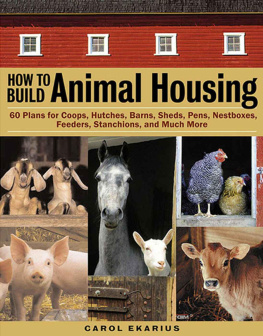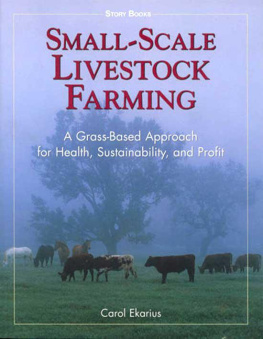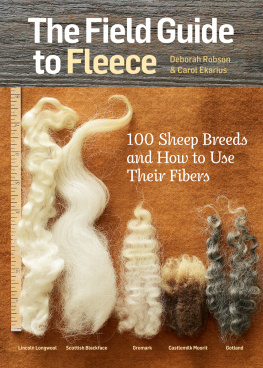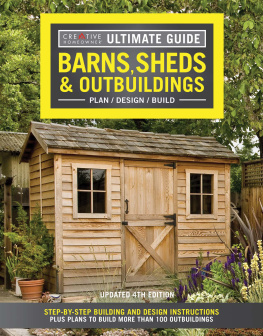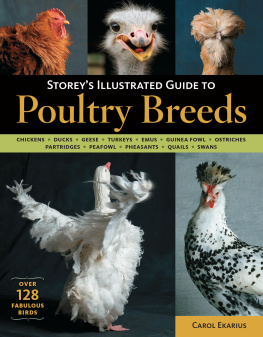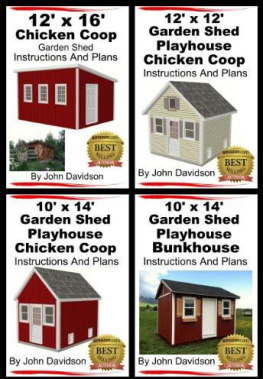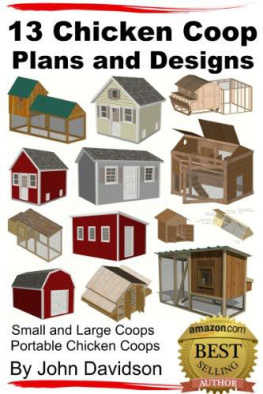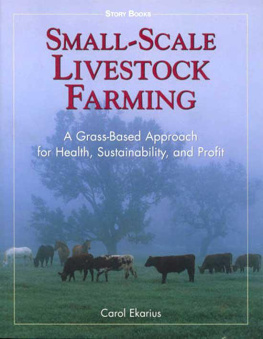HOW TO BUILD
Animal Housing
HOW TO BUILD
Animal Housing
60 Plans for Coops, Hutches, Barns, Sheds, Pens, Nest Boxes, Feeders, Stanchions, and Much More
CAROL EKARIUS

The mission of Storey Publishing is to serve our customers by publishing practical information that encourages personal independence in harmony with the environment.
Edited by Deborah Balmuth and Marie A. Salter
Copyedited by Michael Ashby
Art direction by Lisa Clark
Cover design by Kent Lew
Cover photography by Grant Faint/The Image Bank/Getty (top);
Larry Lefever/Grant Heilman Photography, Inc. (bottom left);
Kent Lew (center right and spine); Photodisc/Getty (center left);
Sabine Stuewer (center); Ben Weddle/Midwestock (bottom right).
Finished building illustrations by Elayne Sears; CAD drawings by Shaun Batho, TSB Consulting; other plans and technical drawings by Brigita Fuhrmann
Text design by Margaret Birnbaum
Text production by Cindy McFarland
Indexed by Jan Williams
2004 by Carol Ekarius
All rights reserved. No part of this book may be reproduced without written permission from the publisher, except by a reviewer, who may quote brief passages or reproduce illustrations in a review with appropriate credits; nor may any part of this book be reproduced, stored in a retrieval system, or transmitted in any form or by any means electronic, mechanical, photocopying, recording, or other without written permission from the publisher.
The information in this book is true and complete to the best of our knowledge. All recommendations are made without guarantee on the part of the author or Storey Publishing. The author and publisher disclaim any liability in connection with the use of this information. For additional information, please contact Storey Publishing, 210 MASS MoCA Way, North Adams, MA 01247.
Storey books are available for special premium and promotional uses and for customized editions. For further information, please call 1-800-793-9396.
Printed in the United States by Versa Press
10 9 8 7 6 5 4
Library of Congress Cataloging-in-Publication Data
Ekarius, Carol.
How to build animal housing / Carol Ekarius.
p. cm.
Includes index.
ISBN 978-1-58017-527-2 (pbk. : alk. paper)
1. LivestockHousingDesign and construction. I. Title.
TH4930.E33 2004
636.0831dc22
FOR ALFRED R. EKARIUS
(July 3, 1929September 14, 2002)
He could build anything;
he could fix anything;
he taught me to try
and encouraged me to live the life I wanted.

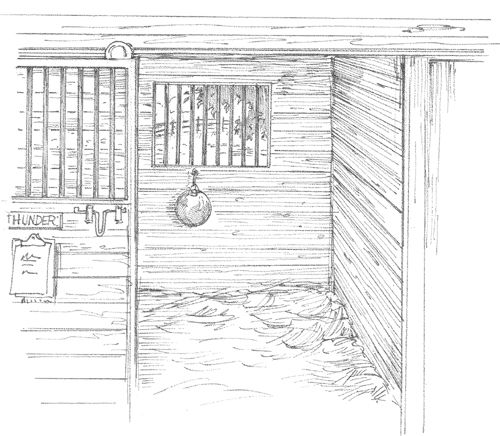
CONTENTS
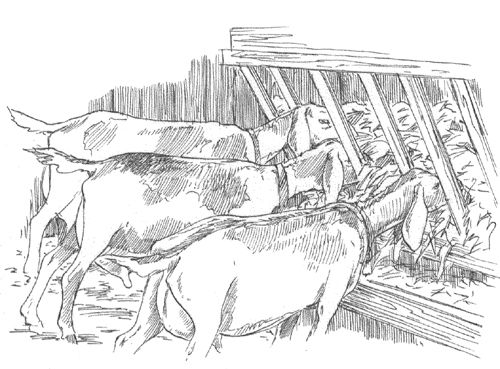
PREFACE
This book is not meant for the industrial agriculture folks who see keeping a hundred thousand chickens under one roof as a great achievement. My goal with this book is to help people who, like Ken and me, fall into the need-animals-in-our-lives group, and particularly those folks who are just starting down the path to animal nirvana.
We want to offer a home for our four-legged and winged friends thats both inviting and safe for them, but that also meets our needs for personal safety, good value, and convenience. Weve raised all kinds of animals, encouraged a wildlife-friendly environment on our farm and ranch, and done all kinds of construction projects. Over a couple of decades, weve learned a great deal about caring for animals and about providing them with the right home.
To paraphrase gardening guru Eliot Coleman, we strongly believe in the values and rewards of the small farm, and we wish to encourage them. Accordingly, most of the emphasis is on housing and shelter for small-scale livestock endeavors.
As with any book, there are many people to whom I owe thanks: First and foremost, I owe thanks to Ken. Not only is he my best friend and true love, he is also our in-house general contractor (Im the gopher, hold-er-up-er, and girl Friday for him on construction projects though I do take credit as the resident electrician).
Thanks also to my friends, the crew of the Coalition for the Upper South Platte. They have carried an extra burden and taken on additional responsibilities so I would be free to work on this book.
The staff at Storey is supportive and great to work with. Writers hear horror stories of publishers being tough to work with, but the Storey crew has always been great to me. For this project, particular thanks go to editors Deborah Balmuth and Marie Salter, and to artists Elayne Sears, Shaun Batho, and Brigita Fuhrmann, who took my scribbles and notes and made sense of them, creating the great illustrations and plans you see here. I also thank Dr. David Kammel, a state Extension and research specialist for livestock housing at the University of Wisconsin, and Dan Herman, a general contractor in Colorado Springs, Colorado, for reviewing the text for me.
We all owe our government a debt of thanks for supporting institutions like the land-grant colleges, the Cooperative Extension Service, the U.S. Forest Service Forest Products Laboratory, and other research organizations. Little of what I have written in this book would have been possible without decades of research and publication by these organizations; much of the information you read here, and most of the plans you see here, are directly attributable to the efforts of their scientists and engineers.
I invite you to visit my Web site often for information on my books and other writing: www.carolekarius.com. From the main page, click E-MAIL ME to drop me a line, or click Q&A to post questions that I will answer on the site.
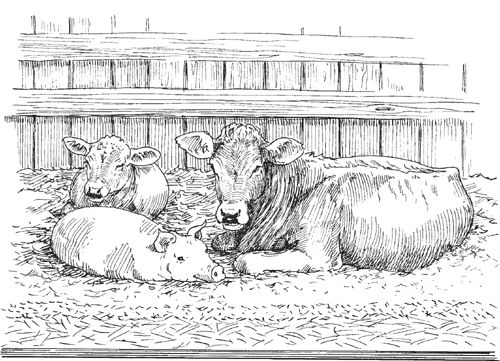
I. PREREQUISITES
Weve all heard the saying Fools rush in where angels fear to tread. If youre like me, you probably get excited about starting projects and want to jump right in, but only a fool would rush to start an animal housing project; haste of any kind costs money and time, and tends to yield a less-than-satisfactory result. So take a lesson from the angels: dont rush. Take plenty of time to think and plan before starting your project.
The chapters in this section are meant to assist you during the planning phase. Studying them will pay long-term dividends for you and your animals, because you will be better able to address important animal health concerns. Adequate ventilation, appropriate flooring, and selecting building materials that are not toxic to animals are all critical; take none of these issues lightly.
also help you address design issues that impact costs and the long-term value of your investment.
Looking ahead, part II, Plans, provides sample plans to inspire the designer in you. Part III, Construction, provides specific construction information for some of the topics introduced here. Be sure to read this material; it will be useful whether you plan to do the work yourself or work with a contractor.
1. SHELTER
Next page
